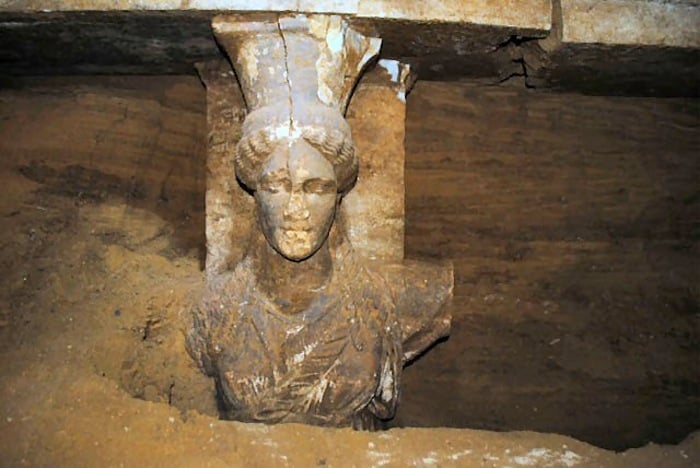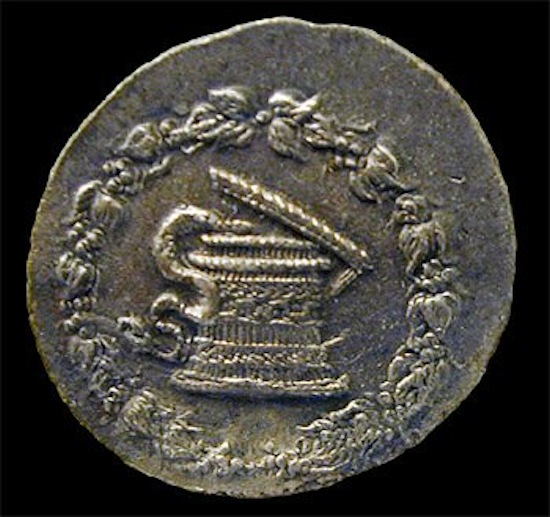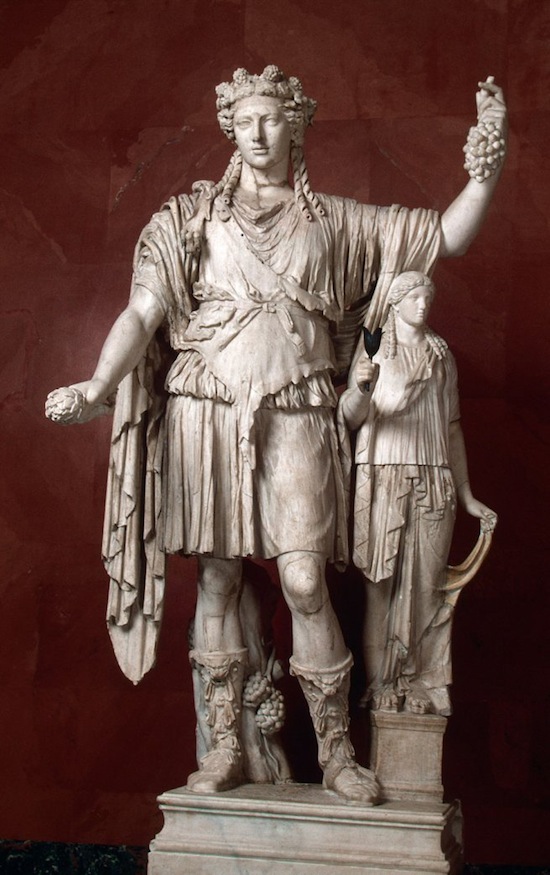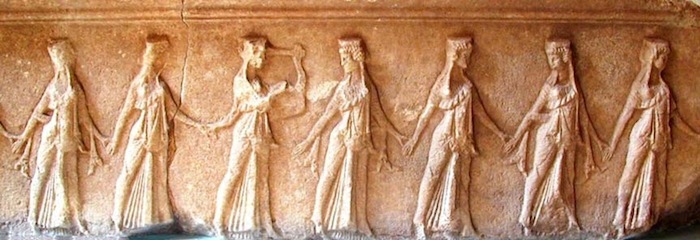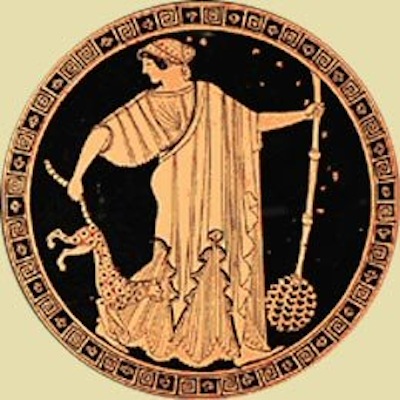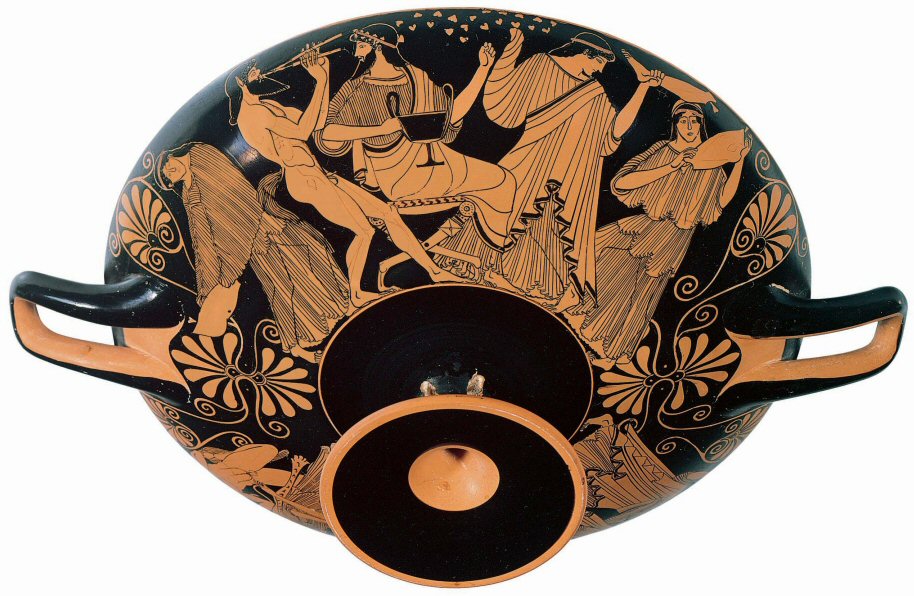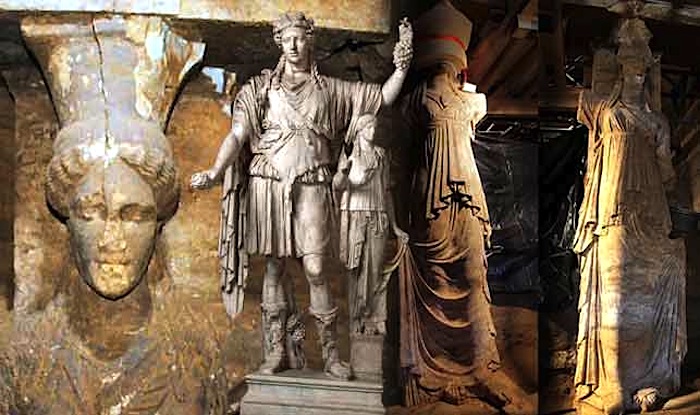
I wrote my initial article on this question on the morning of 6th September (a day before the announcement of the discovery of the caryatids) and I wrote a second part, dealing with the caryatids and a few other issues on 20th September.
In these two articles I drew a number of inferences from the evidence available:
1) Sphinxes decorated the thrones found in the tombs of two mid to late 4th century BC queens of Macedon, one of whom was Alexander’s grandmother Eurydice I
2) Greek mythology recognised Hera the wife of Zeus as the mistress of the sphinx: the 4th century BC Macedonian kings identified themselves with Zeus, so it would make sense for their principal queens to have identified themselves with Hera
3) The female sphinxes at Amphipolis have their closest parallel in a pair of female sphinxes found by Mariette at the Serapeum at Saqqara, which were dated to the reign of the first Ptolemy by Lauer & Picard, mainly on the basis of an associated inscription: the Serapeum at Saqqara is also a strong candidate for the site of the first tomb of Alexander the Great
4) There are strong parallels between the façades of the tombs of Philip II and Alexander IV at Aegae and the reconstructed façade of the lion monument that stood atop the mound at Amphipolis
5) The paving in the tomb at Amphipolis closely matches paving in the 4th century BC palace at Aegae
6) The 8-petal double rosettes in the Amphipolis tomb have an excellent match on the edge bands of the gold larnax of Philip II
7) The evidence therefore favours an important queen being entombed at Amphipolis: Olympias, Alexander’s mother, and Roxane, Alexander’s wife may both have died at Amphipolis and are the only prominent queens that accord with the archaeologists’ firm dating of the Amphipolis tomb to the last quarter of the 4th century BC
8) On the assumption that the occupant of the Amphipolis tomb is Olympias, a straightforward explanation of the caryatids would be that they are Klodones, the priestesses of Dionysus with whom Plutarch, Alexander 2 states that Olympias consorted: the baskets worn on their heads would be those in which Plutarch says the Klodones kept snakes.
9) Plutarch, Alexander 2 tells the story of Philip having dreamt that he sealed Olympias’s womb whilst she was pregnant with Alexander with the device of a lion. This provides an explanation for the tomb having been surmounted by a
lion monument.
In this third part of my episodic commentary on this question I will put forward some evidence that the form of the baskets on the heads of the Amphipolis caryatids is consistent with the types of basket that were actually used by the ancient Greeks to accommodate the snakes used in the worship of Dionysus.
Then I will show additionally that the attire, stance and overall appearance of the Amphipolis caryatids matches ancient Greek representations of priestesses of Dionysus or the female servants of Dionysus known as Maenads.
It is clear that the newly discovered Amphipolis caryatids are members of the large sub-class of caryatids known as canephora: caryatids that bear baskets upon their heads (see Figures 1 and 2).
Canephora are so common and so well studied as to make any other explanation of the caryatids’ headgear at least improbable.
Plutarch, Life of Alexander 2, states that the Klodones of Olympias used to keep snakes in sacred baskets, which they employed in the course of their Dionysiac rites. Specifically, he uses the terminology μυστικῶν λίκνων for the Klodones’s baskets.
The word λίκνων originally meant a wicker fan used for winnowing wheat, but wicker baskets used in festivals of Dionysus came to be known by this name.
Although it is tempting to suppose that the type of basket referred to by λίκνων in some way resembled a winnowing fan, it is obvious that a flat basket could not have accommodated snakes (not for very long anyway!)
Furthermore, there is plenty of ancient evidence available on the form of ancient snake baskets as used in Dionysiac rites.
The Dionysus Sarcophagus from the Metropolitan Museum in New York (Figure 3) depicts a procession including
Dionysus himself at its centre riding astride a panther and wielding his traditional pine-cone tipped wand or thyrsos. Its sculpture depicts a variety of baskets that should be identified as μυστικῶν λίκνων in view of the context.
However, in particular there sits on the ground beneath the feet of the god a small basket with a snake disappearing beneath its lid.
This is very similar in its shape and size to the baskets worn by the Amphipolis caryatids.
The Dionysus sarcophagus dates to ~AD260-270, but there are much earlier examples of Dionysiac snake baskets.
For example a coin minted in ~2BC in Pergamon in Asia Minor is reported to show the cista mystica, i.e. the basket containing the sacred implements of Dionysus worship.
It too includes a prominent snake and is similar to the baskets atop the heads of the caryatids.
It is also possible to find ancient artworks which convincingly show that the Amphipolis caryatids wear the dress and adopt the stance of priestesses of Dionysus.
In particular there are surviving Roman copies of a 4th century BC statue of Dionysus leaning on the diminutive figure of a human priestess in the Metropolitan and Hermitage museums (Figures 5 and 6).
She is a human priestess rather than a goddess, because the statue is a standard type.
There are parallel statuettes of Aphrodite leaning on a diminutive priestess, where the priestess wears a basket.
This means she is bearing offerings for the goddess as well as being physically leant upon and a fellow goddess would not be depicted in such a servile role.
In the case of the Met-Hermitage Dionysus, the priestess has many features that resemble the Amphipolis caryatids. Her stance is similar with one arm upraised and the other lowered to hitch up her dress.
She has the same hairstyle, with three curly locks brought forward over each shoulder.
The Hermitage version wears the same thick-soled sandals as the Amphipolis caryatids.
In particular, the priestess wears a similar dress to the caryatids with a chiton (tunic) worn on top.
The most unusual feature is that the chiton is hung over only one shoulder and its top edge is terminated by a diagonal band running between the breasts and exhibiting curious folds.
This diagonal band seems to be rare in other contexts, so it merits special attention, since it consequently provides relatively strong evidence for the identification of the Amphipolis caryatids as priestesses of Dionysus.
It may be worth noting that the priestess’s chiton and diagonal band appears to echo the panther skin tunic worn by Dionysus himself in the Hermitage statue.
The fact that the chiton it is hung over only one shoulder is more in keeping with the way Greek men wore tunics and therefore recalls Plutarch’s alternative term for the Klodones: Mimallones or “men imitators”.
It is also worth noting a couple of other examples of female figures wearing the single-shoulder chiton with a diagonal band of folds at its top edge.
Firstly, there is a relief depicting dancing women wearing this dress from the Temenos in the sanctuary of the mysteries on the island of Samothrace (Figure 7).
This building is believed to have been constructed between 340-317BC.
Plutarch, just prior to his account of the Klodones, recalls that Olympias (then called Myrtale) first met Philip of Macedon at the mysteries on Samothrace.
The dates of the Temenos make it possible that it was built under the patronage of the Macedonian royal family and it is interesting that the completion of this phase of expansion of the sanctuary (including several other buildings) is dated to the year preceding Olympias’s death.
Secondly, there is a famous Attic red-figure cup depicting the death of Pentheus on its exterior and a Maenad on its interior. It is attributed to Douris and dates to about 480BC (see Figures 8 and 9).
The Maenad, a female follower of Dionysus, also wears the single-shoulder chiton with a diagonal band along its upper edge.
Although this depiction is much earlier that the 4th century BC examples discussed above, the long tradition of this kind of attire among the female servants of Dionysus is probably significant.
of a Greek original of the 4th century BC (Metropolitan Museum) – see also Figure 5
Some have posed the question of who would have constructed such an impressive tomb for Alexander the Great’s mother? They argue that our sources state that Olympias had made herself unpopular by executing some of Cassander’s supporters and that Diodorus 17.118 states that Cassander left Olympias’s body unburied.
However, I answer that her relatives would have been duty-bound to retrive the queen’s remains and that Cassander must subsequently have agreed to allow their entombment. Probably, the tomb would have been commissioned, designed and paid for by Olympias’s relatives and other supporters: Roxane and Alexander IV were kept at Amphipolis for 7 years after Olympias was murdered, so they are likely to have overseen the arrangements. Furthermore, Cassander’s wife was Thessalonike, Alexander’s half-sister and a daughter of Philip II. Then too Alexander’s sister by Olympias, Cleopatra, could well have been involved. She would have been extremely concerned to ensure the appropriate burial of her mother. Olympias had many rich and powerful friends and relatives alive when the lion tomb at Amphipolis was built.
Cassander had to negotiate with the generals then running other parts of Alexander’s empire and these men would have pressurised him to behave properly in the matter of according funeral rites to so important a member of Alexander’s close family.
In summary, I have presented powerful evidence that the Amphipolis caryatids are indeed Klodones with reference both to the baskets borne upon their heads and their close resemblance to priestesses of Dionysus and Maenads in contemporaneous
ancient Greek art.
If they are Klodones, then this is a strong indication that the occupant of the Amphipolis tomb is most likely to be Olympias or else possibly another important queen of Macedon.
There are those who propose that the Amphipolis tomb is either an abandoned cenotaph for Alexander himself or that it is a cult centre and not a tomb at all.
For them the obvious question is: why did somebody take such pains to seal up an empty complex with multiple strongly built sealing walls and of the order of thousands of tonnes of sand from the bed of the local river?
There are those who favour male candidates for the occupant of this tomb.
To them I pose the question of why in this period a male would be assigned two pairs of female guardians for his tomb, when he came from a society where the servants of kings were adolescent boys and the servants of queens were women and girls and in general there was a high degree of segregation between the sexes?
There are those who argue for a date range radically different than that proposed by the archaeologists.
This is difficult, because the archaeologists have apparently found coin and potsherd dating evidence in digging this monument.
It is even more difficult, because there are many matches with late 4th century BC decorative styles in everything so far revealed: especially the flooring match with the 4th century BC palace at Aegae, but also the painted and sculpted decoration in general.
It is especially difficult, because a reconstruction of the demolished Lion Monument done in the 1930s closely echoes the facades of the tombs of Philip II and Alexander IV, not unearthed until the 1970s. It may be added that the band of drafting around the edges of some of the blocks from the Lion Monument matches the band of drafting on the blocks in the perimeter wall of the mound, so any suggestion that the Lion Monument never actually surmounted the Kasta Hill mound is fraught with difficulty.
*Andrew Chugg is the author of The Quest for the Tomb of Alexander the Great and several academic papers on Alexander’s tomb.
See all the latest news from Greece and the world at Greekreporter.com. Contact our newsroom to report an update or send your story, photos and videos. Follow GR on Google News and subscribe here to our daily email!



